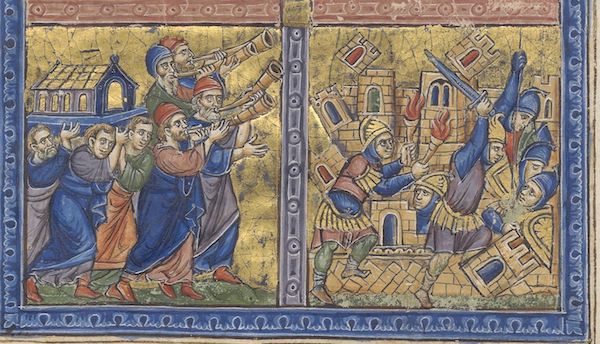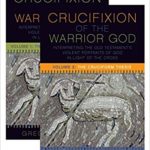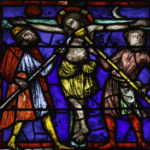We run our website the way we wished the whole internet worked: we provide high quality original content with no ads. We are funded solely by your direct support. Please consider supporting this project.

Reading the Bible “by Faith”
The cruciform approach to reading the Bible—and specifically the culturally-conditioned and sin-stained portraits of God—requires faith on the part of the reader, which I argue in Crucifixion of the Warrior God. On one level we can discern by faith that often times God broke through the limitations and sin of the ancient authors, for we find divine portraits that, to one degree or another, reflect the character of God revealed in Christ. On another level we must discern by faith that God appropriated the limitations and sin of the authors God “breathed” through, for we find divine portraits that, to one degree or another, anticipate the ugliness of the sin-bearing, God-forsaken criminal on the cross. Of course, I am painting with broad brush strokes. In reality, most portraits in the Old Testament are Christ-like to a certain extent and reflect the culturally conditioned and sin-stained humanity of their authors to a certain extent.
To the extent that a divine portrait reflects the character of Christ, it may be regarded as a direct revelation of God’s character. For as with the teachings and actions of Christ, the content of this type of divine portrait directly reflects God’s true, Christ-like character. Conversely, to the extent that a divine portrait conflicts with the character of Christ, it must be regarded as an indirect revelation of God. This calls for a different kind of faith. For as with Christ when he bore our sins and took on the semblance of a guilty, God-forsaken criminal, the content of this type of divine portrait reflects the limitations and sin of God’s covenantal people more than it does his true character.
Along the same lines, as with the sin-bearing Christ on the cross, the indirect revelatory content of this type of divine portrait must be located not at the level of appearances, but in what happened behind these appearances, in what could be called the “meta-dimension” of these appearances. To put the matter in slightly different terms, we only discern the character of God on Calvary when, by faith, we look through the grotesque appearance of this guilty criminal and discern in the depth of this event the unfathomably merciful God stooping to this unthinkable level. We can discern the true character of God in OT divine portraits that look like standard ANE portraits of warrior deities when we, by faith, look through the barbaric appearances to discern the unfathomably merciful God stooping to this unthinkable level.
As such, to the extent that any OT portraits reflects the limited and sinful humanity of God’s people, and insofar as we discern the limited and sinful humanity of God’s people in any other aspect of Scripture, we may discern a harbinger and type of the cross. The same faith that enables us to discern the self-sacrificial God in the depth dimension of the limited and fallen “criminal” who hung on the cross is the faith that enables us to discern the self-sacrificial God in the depth dimension of Scripture’s violent portraits of Yahweh, as well as every other aspect of Scripture that reflects the limited and sinful humanity of its authors. And all of this, I submit, bears witness to the unfailing covenantal love of God.
Image: Bibliothèque de l’Arsenal, Ms-5211 réserve, fol. 69v.
Category: General
Tags: Bible, Cruciform Theology, Faith
Related Reading

Reviewing the Reviews: Tom Belt (Part 2)
In my previous post I reviewed Tom’s critical review of volume 1 of CWG, and in this post I’d like to do the same for his critical review of volume 2. As he did in his review of volume I, Tom begins with some praises and points of agreement. He thinks my quest to discern “what…

The Perfect Love of God
The Father, Son and Spirit exist as the infinite intensity and unsurpassable perfection of eternal love. We know this about the triune God not by speculation but because Jesus demonstrated that love (Rom 5:8) in his willingness to go to the furthest extreme possible to save us. When the all-holy God stooped to become our…

The Cruciform Center Part 3: How Paul’s Epistles Reveal a Cruciform God
As we’ve discussed, the four Gospels point to a cruciform revelation of God (click here and here for a review), but what about the most widely read writer of the New Testament? What did the Apostle Paul have to say about how the cross reveals who God is? Before turning to Paul’s writings, I’d like…

The Phinehas vs. Jesus Conundrum
I’ll be frank. This is not a blog that will be easy for some people to read. But it’s a blog I believe every follower of Jesus should read – even if you have to force yourself to press on. It’s about something we all wish was not true. It’s about the way the Bible…

Podcast: Has Greg ‘Gone Liberal’ in His Cruciform Hermeneutic?
Greg consoles a disappointed fan and discusses Cruciform Hermeneutics. http://traffic.libsyn.com/askgregboyd/Episode_0365.mp3

Sermons: The Church – Week Five
In week five of this sermon series, Greg Boyd discusses what the church should look like in the lens of the cross. A universal Church was born out of the ministry of Jesus, and this Church is empowered to look like the Cross. In this sermon, Greg shows us why it’s so important, as the…
